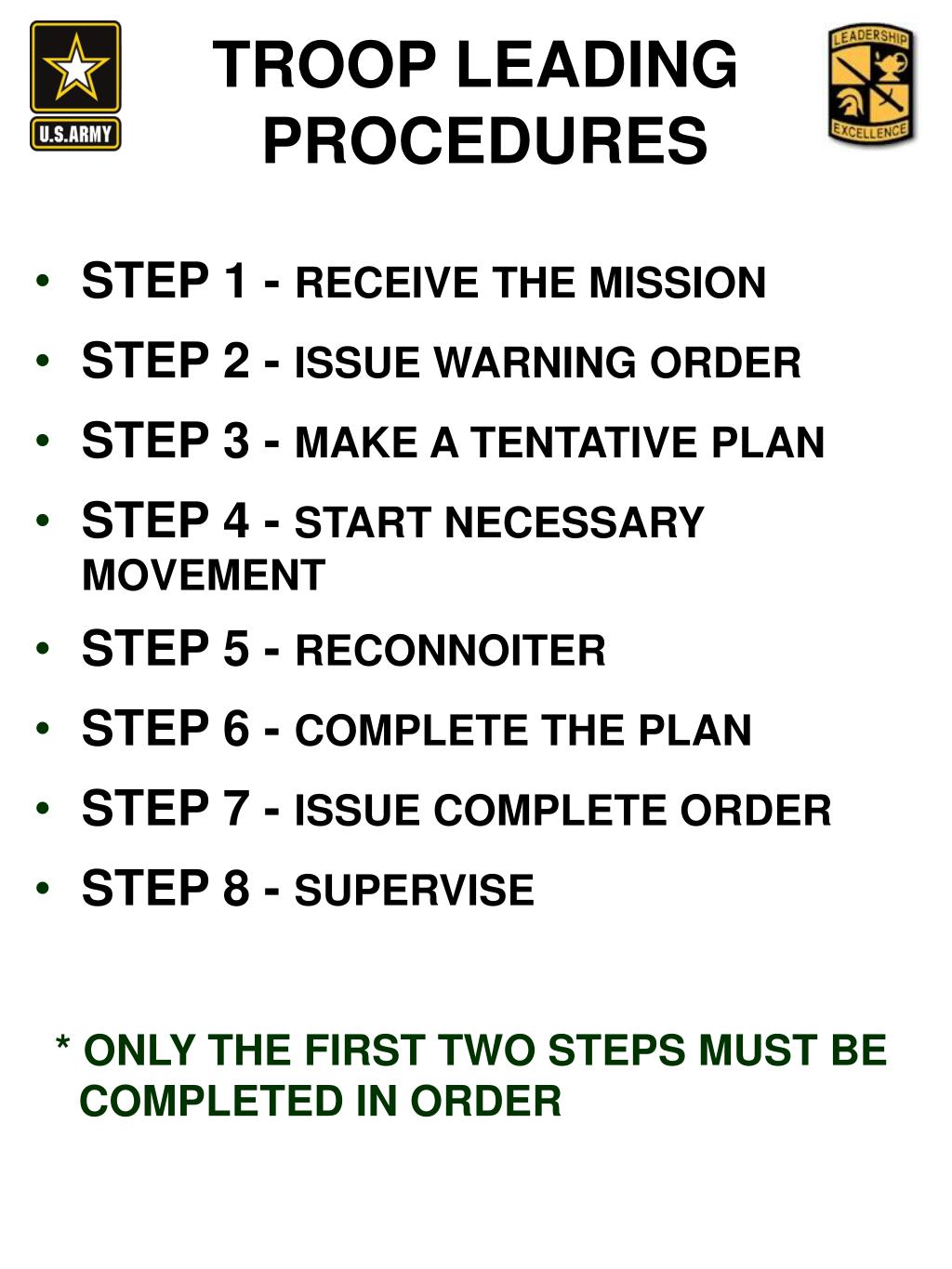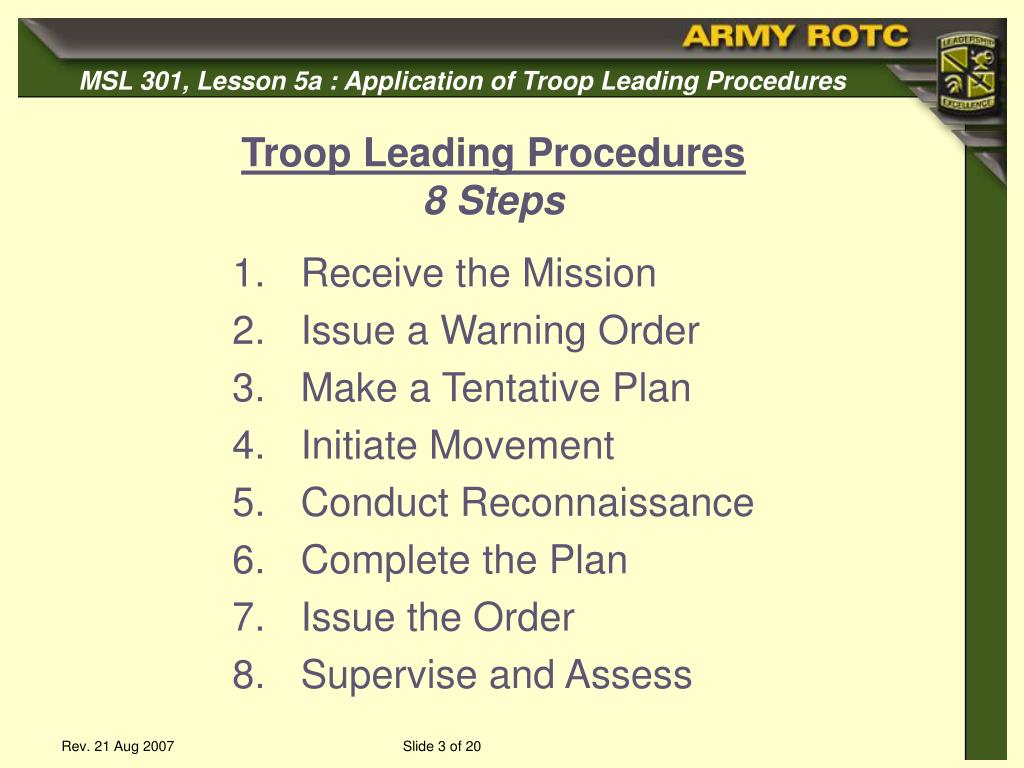Guide To ["Army Fort Benning..."] - Planning & Execution Strategies
Are you ready to embark on a journey into the heart of military leadership, where strategic planning meets the crucible of execution? The Troop Leading Procedures (TLPs) are the unsung heroes of mission success, a proven framework that empowers leaders to transform chaotic situations into coordinated triumphs.
Fort Benning, the Maneuver Center of Excellence, is a crucible where the future leaders of the United States Army are forged. Its a place where tradition and innovation intertwine, shaping the soldiers who will defend our nation. The landscape is constantly evolving, demanding adaptability and unwavering commitment. This article delves into the essential aspects of military leadership, focusing on Troop Leading Procedures (TLPs), the foundation upon which effective command is built. Within the framework of TLPs, soldiers learn to navigate the complexities of modern warfare, from the initial receipt of a mission to its successful completion. The core of TLP lies in a series of steps, carefully designed to ensure that every soldier understands their role and contributes to the overall mission.
At the heart of the Army's operational effectiveness lie the Troop Leading Procedures (TLPs). These procedures are not merely a set of instructions; they are a strategic methodology, a system that guides leaders through the complexities of mission planning and execution. Commanders, from platoon leaders to senior officers, rely on TLPs to transform a vague concept into a detailed, achievable plan, ensuring that every soldier is prepared, informed, and empowered to succeed. A thorough understanding of TLPs is absolutely necessary for any aspiring leader in the United States Army. The system is applicable to any situation, the fundamental principle of TLPs remains constant: analyze, plan, prepare, and execute. TLPs are not set in stone, but rather are an adaptable framework to guide the leader in order to be successful.
- Julia Roberts Twins Hazel Phinnaeus Lives Away From Spotlight Updates
- Ben Stiller Beyond Comedy Rotten Tomatoes Top Picks
The journey begins the moment a platoon leader or any leader receives the initial indication of an upcoming mission. This sets in motion a carefully orchestrated sequence of steps designed to prepare the unit for any eventuality. The process continues throughout the operational process, a continuous cycle of planning, preparation, execution, and assessment. There is a constant interaction between various elements within the troop. The leader must be vigilant and able to adapt to changing circumstances, a key aspect of military leadership. This iterative process allows for flexibility and ensures that the unit is constantly learning and improving.
Consider the critical role of the Operations Order (OPORD). Issued at the conclusion of the planning phase, the OPORD is much more than just a document; it is the definitive guide to execution. It's what translates plans into action, guaranteeing that every soldier understands their role, responsibilities, and the overarching objectives of the mission. The Army (@usarmy) emphasized on December 17, 2024, the importance of the OPORD as a pivotal step in transitioning from planning to execution, underscoring its crucial role in mission success. The OPORD is the voice of the commander, a document that ensures everyone is on the same page. The value of TLPs comes into play with the use of briefs, rehearsals, and inspections. This is what ensures that every soldier understands their role and responsibilities. This reinforces that TLPs aren't merely about procedures; they are about ensuring shared understanding and collective action.
Mastering TLPs is essential for maintaining readiness, adaptability, and operational success. The process of learning and implementing TLPs helps leaders think critically and make informed decisions. It prepares soldiers to meet any challenge. TLPs ensures that every aspect of the mission is considered and accounted for. Through careful planning and preparation, leaders can identify potential risks and develop contingency plans, increasing the likelihood of mission success. This systematic approach allows leaders to proactively manage resources, allocate tasks, and anticipate the actions of the enemy. The ability to adapt plans to changing circumstances is another vital trait nurtured by TLPs. A well-executed TLP process allows for the necessary flexibility and adaptability. The ability to adjust plans to unforeseen events and maintain the initiative are also key elements.
The TLP process, consisting of eight distinct steps, provides leaders with a structured approach to mission planning and execution. While the specific details of each step may vary depending on the mission, the underlying principles remain constant. By following these steps, leaders can ensure that their unit is prepared, organized, and ready to accomplish the mission. TLPs begin when the platoon leader receives the first indication of an upcoming mission. The process then moves through a series of sequential stages.
The first of these is "Receive the Mission." This critical initial phase sets the stage for everything that follows. The initial alert may come from various sources, but the first steps are critical. This stage sets the course for effective planning and execution. The process of receiving the mission involves understanding the mission, the intent of the commander, and the environment. The next step is "Issue a Warning Order." This is a preliminary notice to subordinate units, giving them advance warning of an upcoming mission and providing them with the initial information. The Warning Order is designed to give subordinates the necessary time to prepare. The third step is "Make a Tentative Plan." This involves developing an initial plan. The leader will assess the situation and develop an initial approach to the mission. This early planning helps with time management and also helps avoid the possibility of getting overwhelmed.
The fourth step involves "Initiate Movement." This might involve the deployment of troops to a particular location. The fifth step is "Conduct Reconnaissance." Leaders will gather more information about the enemy and the terrain. In this step, the leader may send out reconnaissance teams, gather intelligence from external sources, and assess the enemy's capabilities. The sixth step is "Complete the Plan." This stage allows for refining the plan, based on information gathered in the previous steps. The leader finalizes the plan and incorporates any necessary changes. The seventh step is "Issue the Operations Order." This step involves communicating the final plan to subordinates. The leader issues a detailed order that provides clear instructions, expectations, and guidance. Finally, the eighth step is "Supervise and Refine." The leader must be prepared to make changes if the environment changes or if circumstances dictate. This step is crucial to ensure that the plan stays on track, and if necessary, is adapted.
The MDMP (Military Decision Making Process) and the TLP are similar in their objective: to develop and execute a plan to accomplish the mission. The MDMP is typically used by commanders and their staff to plan operations. In comparison, TLPs are designed for the use of smaller units. The MDMP is more comprehensive and involves more staff resources, whereas the TLP provides a streamlined, more simplified approach. They both are designed to ensure that military operations are conducted effectively and safely.
The investigation of TLPs was first recognized by members of JRTC's Warrior Leadership Council, highlighting the need for continuous assessment and improvement of these procedures. This commitment to evaluation and improvement is critical to ensuring that TLPs remain relevant and effective. This demonstrates a commitment to enhancing the effectiveness of training, procedures, and systems. It shows a commitment to the constant advancement of the Army. Constant vigilance is key to maintaining the Army's edge. The application of these procedures is a never-ending cycle of learning, refining, and adaptation.
The United States Army Human Resources Command has made efforts to make soldiers the primary focus. These efforts underscore the value of the individual. The Army's focus on its personnel enhances readiness and promotes the welfare of the soldiers. These actions are a part of a larger effort to create a strong, adaptable, and resilient force. These elements are foundational to the Army's ability to succeed in any mission. The focus on soldiers is a testament to the importance of human capital.
For anyone seeking information on various aspects of the Army, the official websites and publications offer reliable sources. The official site is a gateway to various resources, including information on policies, procedures, and benefits. For those who are interested in more in-depth information on planning trips, there is a separate resource available for the Trips Assessment, a valuable tool for planning travel. This website guides users through the process of filling out their trips worksheet step by step. This resource assists in calculating travel routes, times, and distances and provide risk assessments. This also offers automatic formatting into a PDF and sending it via email.
- May 24th Zodiac Gemini Traits Personality Insights
- Kyla Galers Age Bio What You Need To Know Updated

PPT TROOP LEADING PROCEDURES PowerPoint Presentation, free download

PPT Application of the Troop Leading Procedures PowerPoint

FA BATTERY TROOP LEADING PROCEDURES THE NEXT STEP